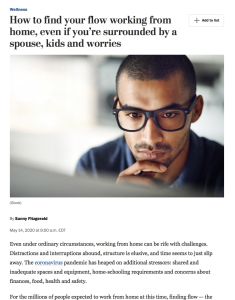
Article
How to find your flow working from home, even if you’re surrounded by a spouse, kids and worries.
The Washington Post,
2020
1×
Faça o Login para ouvir o resumo em áudio.
Recommendation
If you’re working from home during the coronavirus pandemic, you may already be coping with anxiety and stress. Beyond the everyday challenges and distractions of family life or inadequate office space and equipment, you may have difficulty concentrating or being productive. Sunny Fitzgerald, writing for The Washington Post, offers simple, doable suggestions from neuroscientists and flow experts to help you make the most of your external and internal environment.
Summary
About the Author
Sunny Fitzgerald’s blog (thisissunny.com) covers travel, culture, health and wellness.
Learners who read this summary also read
Related Skills

Torne-se mais produtivo

Construa e mantenha o bem-estar

Lidere a si mesmo

Liderança

Domine a colaboração

Crescimento pessoal

Competências comportamentais

Aprimore o seu foco

Aprimore a sua saúde mental

Habilidades no ambiente de trabalho

Pratique o mindfulness

Trabalhe Remotamente

Cultive a autodisciplina

Comment on this summary